This information is based on a presentation given at the Kentucky Nursery and Landscape Association Green Industry Summer Summit in Louisville, Kentucky June 2022 by Andrea Wilson Mueller, CPLD (Inside Out Landscape Design) and Jacob Stidham (Yew Dell Botanical Gardens)
More people are gravitating toward native plants with the goal of supporting pollinators and avoiding invasives. Unfortunately, with the wide audience of social media, the term “native” often loses its meaning and other terms such as aggressive and invasive are misunderstood. The basic definition of a native plant according to the USDA is “A plant that is a part of the balance of nature that has developed over hundreds or thousands of years in a particular region or ecosystem. Note: The word native should always be used with a geographic qualifier (that is, native to New England [for example]). Only plants found in this country before European settlement are considered to be native to the United States.[1]”
Some examples of plants that are native to our particular geographic area (eastern North America) include perennials such as Joe Pye Weed (Eupatorium purpureum), Coneflower (Echinacea pallida, Echinacea paradoxa, Echinacea purpurea, Echinacea simulate, Echinacea tennesseensis), Black Eyed Susan (Rudbeckia fulgida, Rudbeckia hirta, Rudbeckia lacinata, Rudbeckia maxima, Rudbeckia subtomentosa, Rudbeckia triloba), False Indigo (Baptisia australis), and Tickseed (Coreopsis tripteris). Shrubs and trees native to our area include Buttonbush (Cephalanthus occidentalis), Sweetgum (Liquidambar styraciflua), Bigleaf Magnolia (Magnolia macrophylla), Black Gum (Nyssa sylvatica), White Pine (Pinus storbus), Bald Cypress (Taxodium distichum), and Eastern Hemlock (Tsuga canadensis).

Eupatorium purpureum
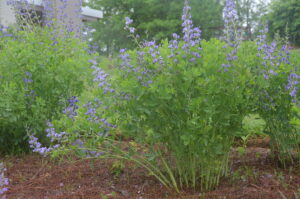
Baptisia australis
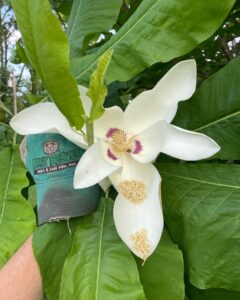
Magnolia macrophylla
An “exotic” plant is defined as “A plant not native to the continent on which it is now found. (Plants from Europe are exotic in North America; plants from North America are exotic in Japan.).” In an ideal world would each geographic area only have native plants? If that were the case, we would miss the bright blooms of exotics such as the Peony (Paeonia spp) and Cardoon (Cynara cardunculus), and the unbelievable foliage and unique blooms of the Cobra Lily (Arisaema fargesii). The Maidenhair tree (Ginkgo biloba) surely serves a purpose in our landscapes where it provides a visually stunning display when its leaves change to gold each year. Exotics, such as the evergreen Japanese Plum Yew (Cephalotaxus harringtonia), the Plantain Lily (Hosta), and the Bigleaf Hydrangea (Hydrangea macrophylla) now are so common in our landscapes they’ve become staples. Another exotic staple in our landscape as well as our gastronomy….the tomato plant (Solanum lycopersicum). Yes, even our traditional tomato technically is an exotic.
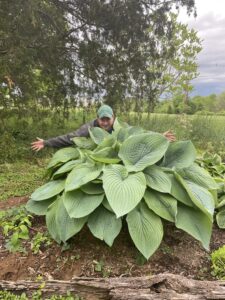
Hosta
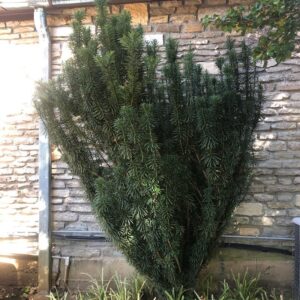
Cephalotaxus harringtonia
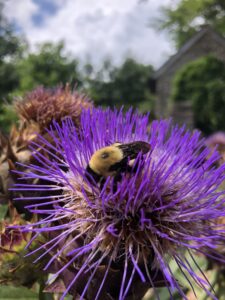
Cynara cardunculus
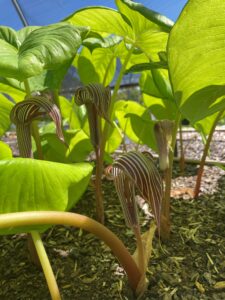
Arisaema fargesii in bloom
So what’s the big deal? Why do we need to care? Here is where it gets tricky. Even a plant that is native to our area can be considered aggressive or opportunistic. According to the USDA, these natives are “able to take advantage of disturbance to the soil or existing vegetation to spread quickly and out-compete the other plants on the disturbed site.” Although they can choke out other plants, they are important contributors to our ecosystem. Rather than refuse to plant them, we must instead pay particular attention to where we plant them. For example, Obedient Plant (Physistegia virginiana) will take over an entire plant bed if it is allowed to do so…ironic common name, right? In the right setting though, the same plant is unbeatable for erosion control. Mountain Mint is another good example of an aggressive native. It is vital for our pollinators and can be kept under control by pruning the roots with a spade. Other examples of aggressive natives include Meadow Anemone (Anemone canadensis), Black Eyed Susan (Rudbeckia), Yarrow (Achillea millefolium), Wild Bergamot (Monarda fistulosa), Virginia Creeper (Parthenocissus quinquefolia), Black Raspberry (Rubus occidentalis), and Cup Plant (Silphium perfoliatum). Let’s not forget the aggressive native trees as well. These include Hackberry (Celtis occidentalis), Cherry (Prunus serotina), Eastern Redbud (Cercis canadensis), Eastern Red Cedar (Juniperus virginiana), and American Sycamore (Platanus occidentalis).
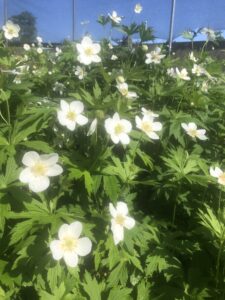
Anemone canadensis
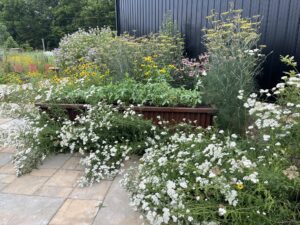
Rudbeckia Achillea millefolium Monarda fistulosa

Rubus occidentalis
Just like the natives, exotic plants include those that are considered aggressive or opportunistic. An exotic aggressive is defined as “a non-native plant able to spread quickly and out-compete the other plants.” Similar to the aggressive native examples, these plants can have a place in our landscapes as long as their behavior is taken into consideration and addressed. To name a few, aggressive exotics include Sedum (Sedum kamtschaticum), St. John’s Wort (Hypericum calycium), Japanese Hydrangea Vine (Schizophragma hydrangeoides), and Japanese Spurge (Pachysandra terminalis).
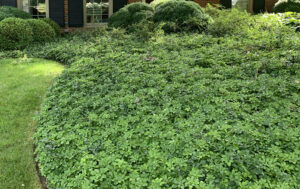
Pachysandra
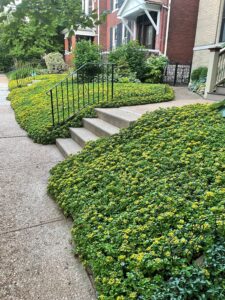
Sedum kamtschaticum
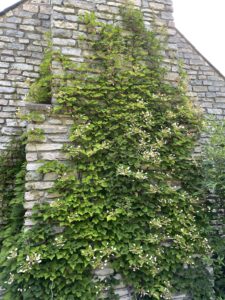
Schizophragma hydrangeoides
So we have covered native, exotic, native aggressive, and exotic aggressive. Now for the category of plants that must be avoided altogether, invasives. The USDA defines invasive as “non-native (or alien) to the ecosystem under consideration; and whose introduction causes or is likely to cause economic or environmental harm or harm to human health.” If you are wondering how a plant could possibly cause economic or environmental harm, let me introduce you to possibly the most notorious invasive plant in our area, Japanese Honeysuckle (Lonicera japonica). This particular vine can not only take over an entire area, but overtime can smother entire trees and forests by twining and forming dense canopies and matting. In addition, the vine can spread through seeds that are distributed by birds and mammal droppings.
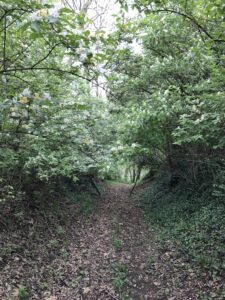
Lonicera japonica
Another unfortunately common invasive in our region is the Callery pear (Pyrus calleryana). Read our earlier blog “Callery Pear, Let’s Take Out the Trash” for more information on this notorious tree. Golden Rain Tree (Koelreutena paniculate), Burning Bush (Euonymus alatus), Japanese Barberry (Berberis thunbergia), Chinese Silver Grass (Miscanthus sinensis), Porcelain Berry (Ampelopsis brevipedunculata), and Vinca Vine (Vinca minor) are just a few of the invasives that have been introduced to our area. Another notorious one is Wintercreeper (Euonymus fortune). Similar to Japanese honeysuckle, it forms canopies and matting that choke out forested areas. Unfortunately, all of these are still sold at nurseries in our area. There are numerous native alternatives to these invasives. You just have to do a little homework. See below for a guide on alternative plant material. If we do not address the invasives that we are planting and allowing to grow, we as humans are becoming the worst invasive of all!
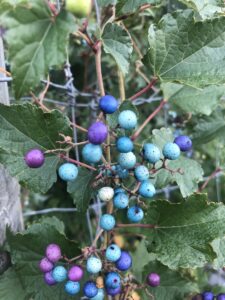
Ampelopsis brevipedunculata
For a guide on alternatives to invasive plants visit the Kentucky Garden Club’s website: https://www.gardenclubky.org/wp-content/uploads/2014/02/KY_native_alternatives.pdf
Other useful sources:
https://www.fs.fed.us/wildflowers/pollinators/documents/AttractingPollinatorsV5.pdf
http://naturepreserves.ky.gov/Pages/default.aspx
https://www.mnn.com/earth-matters/wilderness-resources/blogs/11-startling-stats-about-earths-disappearing-wildlife
http://www.missouribotanicalgarden.org/
https://plants.sc.egov.usda.gov/home